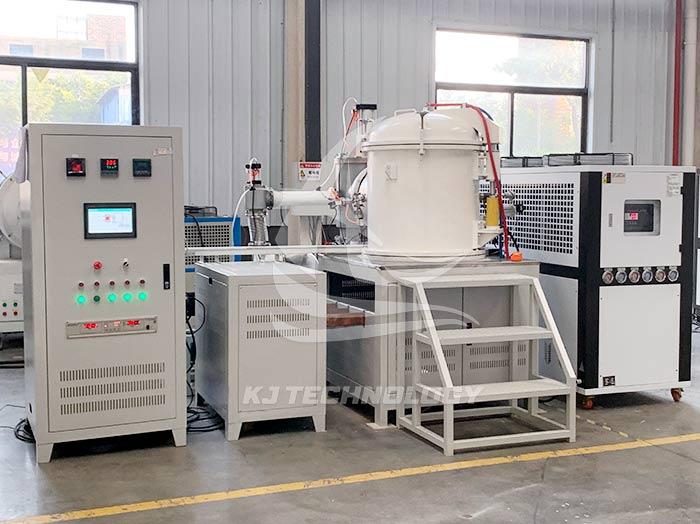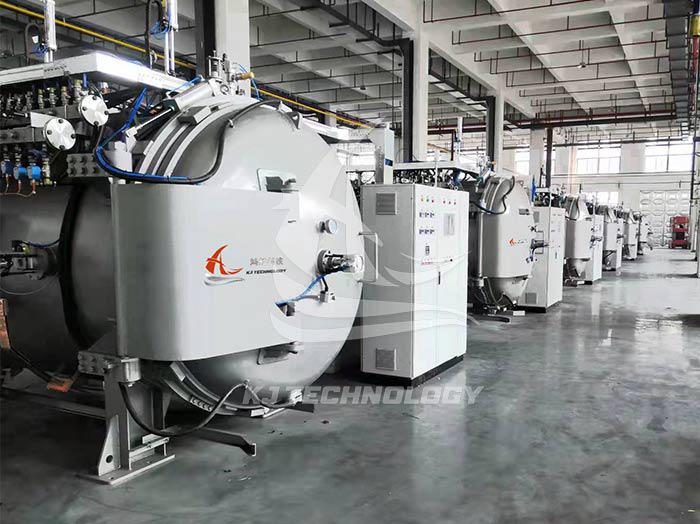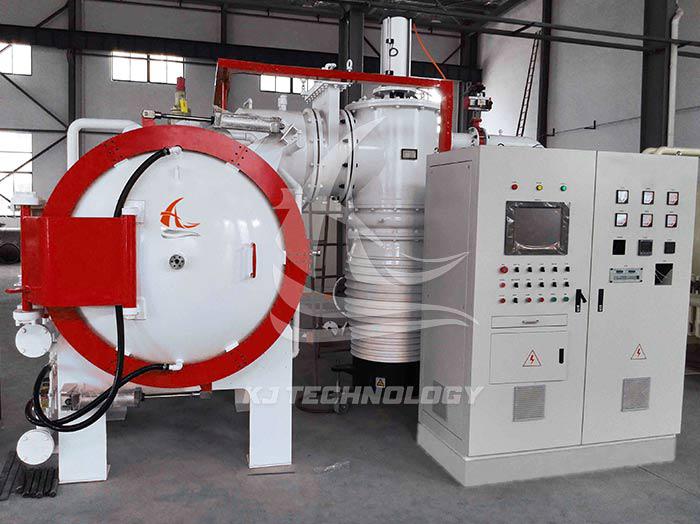High vacuum brazing electric furnace metal brazing
 10-31-2025 Author: KJ technology
10-31-2025 Author: KJ technology
Application and Advantage Analysis of High Vacuum Brazing Electric Furnace in Metal Brazing
1. Core functions and technical features
Vacuum environment control
The high vacuum brazing electric furnace uses a multi-stage pump set (mechanical pump, Roots pump, diffusion pump, etc.) to pump the vacuum degree inside the furnace to the level of 10-3Pa to 10-4Pa, effectively eliminating oxygen, nitrogen and other gases in the air, avoiding metal oxidation, decarburization or carbonization at high temperatures, ensuring that the welded joints are clean and bright, and do not require subsequent cleaning.
Accurate temperature control
Adopting high-precision temperature control instruments (such as PLC+touch screen) and partitioned heater layout to achieve uniform temperature distribution inside the furnace. Typical equipment has a temperature control accuracy of ± 1 ℃ and a high temperature uniformity of ± 5 ℃. It supports multi-stage program temperature control (such as heating, insulation, and cooling curves) to meet the brazing process requirements of different metals.
Rapid heating and cooling
It takes less than 90 minutes for the furnace temperature to rise from room temperature to 1500 ℃, and less than 30 minutes to cool down to 200 ℃, shortening the production cycle and improving efficiency. Some devices are equipped with external rapid cooling systems to further accelerate cooling.
Modular and Automated Design
The equipment adopts an integrated compact layout, and some models are equipped with a bottom electric lifting and unloading system and mobile wheels for easy operation and maintenance. PLC fully automated control, supports 30 segment programming, multiple program storage, can export temperature and vacuum curves, and achieve unmanned production.
2. Application field of metal brazing
aerospace
Engine components: brazed turbine blades, guides, diffusers, and other high-temperature alloy components to ensure joint strength and airtightness.
Heat exchange system: Manufacturing honeycomb sandwich structure wall panels and jet engine assemblies to improve heat exchange efficiency.
Single crystal alloy welding: using transition liquid phase diffusion welding (TLP) technology to achieve defect free connection of single crystal blades.
automotive industry
Turbocharger: brazed intercooler and exhaust system to improve high temperature resistance and reliability.
Aluminum alloy components: Welding radiator core strips and oil coolers to reduce weight and improve heat exchange performance.
Stainless steel brazing: Manufacturing automotive components such as sensors and connectors to ensure joint corrosion resistance.
electronic device
Power semiconductor packaging: brazing IGBT module substrates and ceramic copper-clad laminates (such as AMB process) to improve thermal conductivity and reliability.
Precision components: Welding micro circuit boards and connectors to meet high-precision and high cleanliness requirements.
medical device
Surgical instruments: brazed stainless steel and titanium alloy tools to ensure joint strength and biocompatibility.
Implant manufacturing: Welding orthopedic and dental implants to avoid oxidative contamination and enhance safety.
Tool manufacturing
Diamond cutting tools: brazed PCD (polycrystalline diamond) and CBN (cubic boron nitride) cutting tools to improve cutting performance and lifespan.
Hard alloy cutting tools: welding carving knives, drilling bits, meet the requirements of complex shapes and high strength.
3. Summary of Advantages
High quality welding
Vacuum environment avoids oxidation, with bright and dense joints, excellent mechanical properties and corrosion resistance, meeting high demand scenarios such as aerospace and medical.
Wide adaptability of materials
Can be brazed with aluminum, copper, nickel, stainless steel, high-temperature alloys, titanium alloys, ceramics, metal matrix composites, etc., especially suitable for active metals (such as titanium, zirconium) and refractory metals (such as tungsten, molybdenum).
High process flexibility
Supporting welding of complex shaped parts (such as narrow grooves and blind holes), multiple adjacent welds can be brazed at once or multiple components can be brazed in the same furnace to improve efficiency.
Environmentally friendly and cost optimized
No flux pollution, avoiding corrosion and cleaning processes, reducing post-processing costs; At the same time, the vacuum environment improves material properties and reduces waste rates.
4. Typical equipment parameters
Temperature range: 750 ℃ to 2300 ℃ (different models are suitable for low-temperature aluminum based brazing or high-temperature alloy brazing).
Vacuum degree: The cold state limit vacuum degree is 6.67 × 10 − 1Pa to 6.67 × 10 − 3Pa.
Furnace size: from Φ 200 × 200mm to customized size (such as 400 × 400 × 600mm).
Temperature control accuracy: ± 1 ℃, high temperature uniformity ± 5 ℃.
Automation level: PLC+touch screen control, supporting 30 segment programming, data export, and fault diagnosis.








